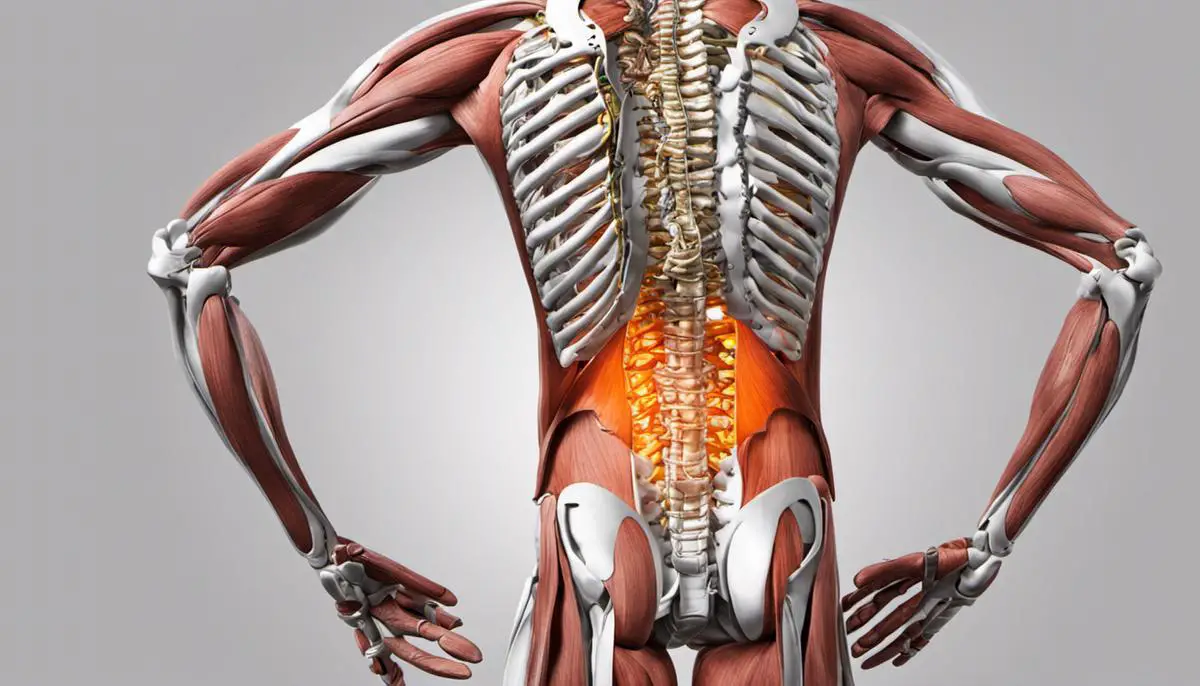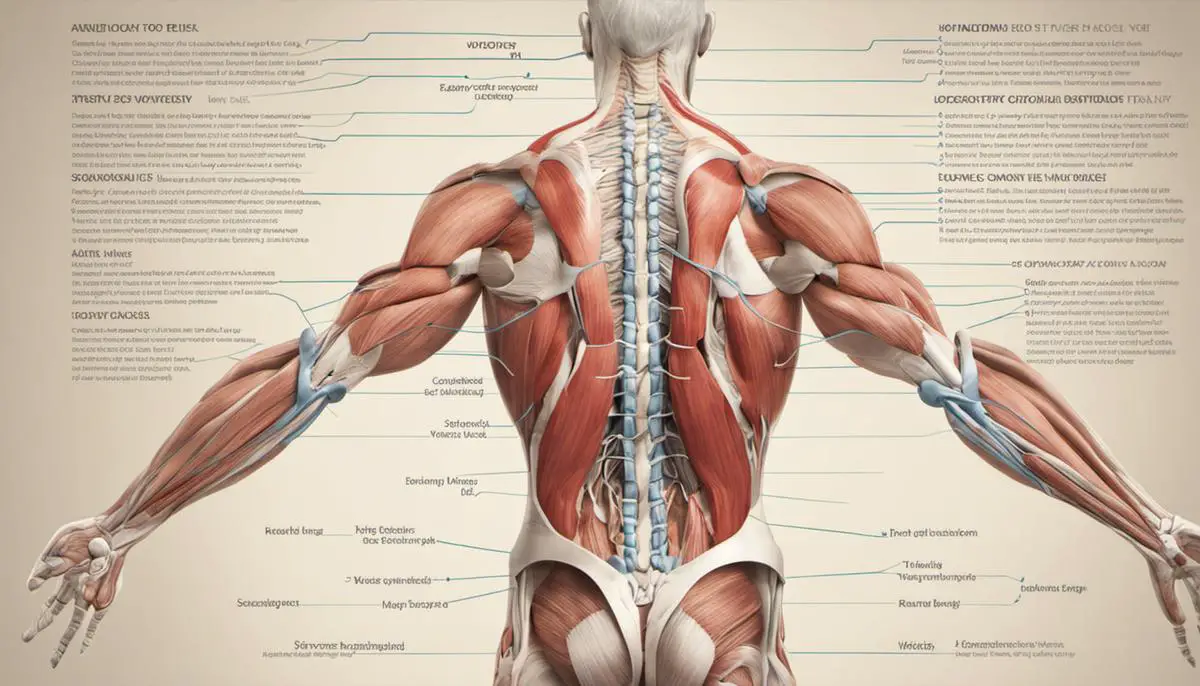Untapping the potential of lower back health often begins with an understanding and appreciation of its intricate mechanics. The lower back is not only the pillar of your body but also serves as the lifeline connecting upper and lower body movements. Recognizing the instrumental role of the lower back muscles and their relation to the overall body function is pivotal. Moreover, the impact of stretching on lower back strength is profound; it oscillates between injury prevention, enhancing flexibility, and fostering strength. Through a variety of targeted stretching exercises, we can harness the power of this underserved area and observe noticeable enhancements in our overall fitness. Furthermore, it’s not just about understanding these exercises, but tailoring a regular personal stretching routine that caters to your lifestyle and needs.
Understanding the lower back
Understanding the Lower Back Anatomy
The human lower back, or the lumbar region, consists of five vertebrae titled L1-L5. In between these vertebrae are discs filled with a gel-like substance that cushion the bones and prevent them from rubbing against each other. This part of the back also has a complex structure of muscles and ligaments that provide it stability while facilitating movement.
The muscles in the lower back are connected to the hips and the abdominal muscles, forming what’s often referred to as the ‘core’ of the body. This interconnected network is crucial for overall body strength and stability. Therefore, when you’re looking to strengthen your lower back, you are also indirectly working on strengthening your core.
The Role of Lower Back Muscles
The primary muscles of the lower back include the erector spinae, quadratus lumborum, and the lower parts of the trapezius and latissimus dorsi. These muscles work together to support the spine, maintain posture, and allow for movements like bending and twisting.
For instance, the erector spinae run along either side of the spine and are crucial in allowing us to stand upright and rotate our backs. The quadratus lumborum is particularly responsible for side-to-side movements and stabilizing the lower back.
The Importance of Lower Back Strength
Maintaining good lower back strength is vital not just for physical health, but also for functional daily activities. This part of the body is involved in almost every movement we make – from lifting items and bending over, to sitting for long periods and even standing.
Strong lower back muscles can help maintain proper posture and alignment, reduce the risk of injury and alleviate common issues such as lower back pain. Many people who suffer from lower back pain often have weak lower back muscles. Therefore, regular stretching and strengthening exercises can go a long way in managing such conditions.
Link to Other Body Parts
Given the connection between the lower back and other body parts, strengthening the latter can also enhance overall body strength and stability. For instance, the hip muscles (glutes and hip flexors), as well as the abdominals, work in tandem with the lower back muscles. Thus, a strong lower back contributes to reinforced abdominal muscles and vice versa. Similarly, a strong lower back can lead to better hip mobility and strength.
Remember, a well-rounded exercise routine which incorporates lower back stretches, along with exercises for other connected muscles, can help maintain overall body strength and health.

Importance of stretching for lower back
Understanding the Importance of Lower Back Stretching
Stretching is a vital component of overall physical fitness and wellness. Focusing specifically on the lower back, it plays a significant role in maintaining strength and mobility. This region of the body plays a crucial role in body support and movement, and neglecting its care can result in discomfort, pain, and mobility issues.
Stretching for Injury Prevention
Stretching is a preventative measure that can strengthen the lower back and mitigate the likelihood of injuries. Lower back injuries are frequently associated with tense or weak muscles. Regular stretching aids in loosening the muscles and reducing muscle tension, in turn, lowering the risk of injury.
Stretching for Enhancing Mobility
The range of motion in your lower back is another aspect that is directly impacted by regular stretching. When muscles become stiff, it becomes challenging to move naturally and comfortably. Introducing a routine of lower back stretching exercises contributes to enhanced mobility by maintaining muscle flexibility.
Stretching for Promoting Strength
Stretching is not only about flexibility; it’s also about strength. Having strong lower back muscles is essential for maintaining proper posture and alleviating strain on the spinal column. Regular stretching helps to promote muscle health, contributing to an overall stronger lower back.
Stretching for Health and Pain Management
In addition to injury prevention and improved mobility and strength, stretching also contributes to overall health management. It’s known to improve circulation, allowing better nutrient distribution across the body, including the lower back, which can expedite healing and growth. Plus, regular stretching can alleviate chronic lower back pain, making it an excellent tool for pain management.
Incorporating Stretching Into Routine
In your routine, consider incorporating specialized stretches that target lower back muscles, such as the lumbar region and sacroiliac joints. Options like the Child’s Pose, Seated Forward Bend, Cat-Cow stretch, or a simple knee-to-chest stretch can be highly beneficial.
Remember, it’s essential to stretch both before and after physical activity. However, even on non-exercise days, taking a few minutes to stretch can greatly contribute to lower back health.
While the benefits of stretching for lower back strength are numerous, it’s crucial to stretch properly and safely to avoid injuring yourself. Always ensure to use correct techniques in all your stretches to maximize the benefits and protect your body.

Different lower back stretching exercises
Stretching Exercise 1: Knee to Chest Stretch
The Knee to Chest Stretch is a basic exercise that targets your lower back and the gluteal muscles beside it. Lie flat on your back on the ground with both your feet flat and your knees bent. Pull one knee up to your chest, while keeping the other foot on the ground, and the lower back pressed against the floor. Hold the stretch for 20 seconds and slowly return your knee to the starting position. Repeat the stretch with the other knee. This will improve flexibility in the lower back and hips, increase mobility and enhance your overall posture.
Stretching Exercise 2: Trunk Rotation Stretch
The Trunk Rotation Stretch helps to improve the flexibility of the lower back and the trunk of the body. Start by lying on your back, bend your knees, and keep both feet flat on the ground. While keeping your shoulders firmly on the floor, roll your bent knees over to one side. Hold the position for 20 seconds, then return your knees to the center. Repeat the stretch on the other side. This exercise helps to strengthen the muscles in your lower back and improve your range of motion.
Stretching Exercise 3: Cat-Camel Stretch
The Cat-Camel Stretch is an intermediate level stretch targeting the muscles of the lower back. Start on your hands and knees with your hands under your shoulders, and your knees under your hips. Slowly arch your back upwards like a scared cat, then flatten it back out and dip it towards the ground like a camel. Be sure to make these movements slowly and smoothly, without jerkiness or haste. Repeat these movements for 15-30 seconds. The Cat-Camel stretch works on the lower back muscles and enhances the spine’s flexibility.
Stretching Exercise 4: Seated Lower Back Rotational Stretch
For a sitting stretch option, the Seated Lower Back Rotational Stretch can be a good choice. Sit on a chair with your feet flat on the ground. Cross your right leg over the left leg at the knees. Place your left elbow on the outside of the right knee and gently apply pressure while looking over the right shoulder. After holding for 20-30 seconds, switch sides and repeat. This seated stretch helps increase flexibility along with strengthening the lower back and abdominal muscles which are instrumental in maintaining a healthy and strong back.
Stretching Exercise 5: Child’s Pose
Child’s Pose is an advanced-level stretch that targets the back, hips, and thighs. Start on all fours, then push your hips back until they’re resting on your heels. Allow your forehead to rest on the floor while your arms are extended. Hold this pose for 20-30 seconds, then return to the starting position. It’s an excellent stretch for releasing tension in the lower back and enhancing overall flexibility.
Safety should be the top priority while doing all these exercises. If you feel sharp or intense pain, stop the exercise immediately, and consult with a healthcare provider or a fitness professional. Regular practice of these stretching exercises can significantly improve your lower back strength and overall flexibility.

Implementing a regular lower back stretching routine
Implementing a Regular Lower Back Stretching Routine
To maintain or improve lower back strength, it’s important to follow a routine that includes specific lower back stretches. One beneficial exercise is the cat-camel stretch. Get on all fours with your hands under your shoulders and your knees under your hips. Slowly arch your back, like a cat, and hold for 5 seconds. Then lower your stomach towards the floor making a U-shape with your back, like a camel, and hold for another 5 seconds. Do this 3-5 times.
Next, stretch your lower back with a knees-to-chest stretch. Lie on your back with your knees bent and your feet flat on the floor. Pull one knee into your chest while keeping the other foot on the floor. Hold for 15 to 30 seconds. Switch to the other knee and repeat. Do 10 repetitions for each side.
The pelvic tilt is another great lower back stretch. Lie on your back on a flat surface, bend your knees while keeping your feet flat, and tighten your abdominal muscles while pushing your lower back onto the floor. Hold the position for 10 seconds while breathing deeply in and out. Repeat this 10 times.
Understanding When and How Often to Stretch
Research suggests that the ideal time to stretch is when your muscles are already warmed up. This could be first thing in the morning after a light walk or jog, or after a more intensive workout session.
As for how often you should stretch, the American College of Sports Medicine (ACSM) recommendation for flexibility training is at least two to three times a week. However, stretching can be beneficial and safe to do every day.
Warming Up Before Stretching and Cooling Down Afterwards
It’s important to warm up your body before you start stretching to improve circulation and prepare your muscles for exercise. A simple warm-up could include 5-10 minutes of light cardio activities, such as walking or jogging.
After stretching, a cool-down period allows your heart rate and breathing to return to normal. It also helps to prevent stiffness and improve flexibility. A cool-down is similar to a warm-up – it should involve light activities. These can include a slow walk or a gentle stretch, ensuring that you’re supporting your lower back throughout. A cool-down should take approximately 5-10 minutes.
Maintaining a Regular Lower Back Stretching Routine
Maintaining a regular lower back stretching routine is crucial in ensuring lower back strength and flexibility. Consulting with a healthcare professional before starting a new exercise routine is always a good idea, especially if you have chronic back pain or any other health conditions.

Wrapping up, keeping our lower back robust and healthy is pivotal, contributing significantly to our overall wellness and mobility. Stretching is an uncomplicated yet highly effective approach to fortifying these muscles and enhancing their functionality. By demystifying different lower back stretching exercises, it empowers us to incorporate them seamlessly into our daily schedules. It’s about embracing the art of warming up before stretching and cooling down afterward, comprehending when’s the best time to stretch, and gauging how often we should do this. Continuity is the key to success; hence, developing and observing a personal lower back stretching routine will bring the desired results. The journey to rediscover your lower back strength starts now, and every stretch takes you a step closer to your goal.
